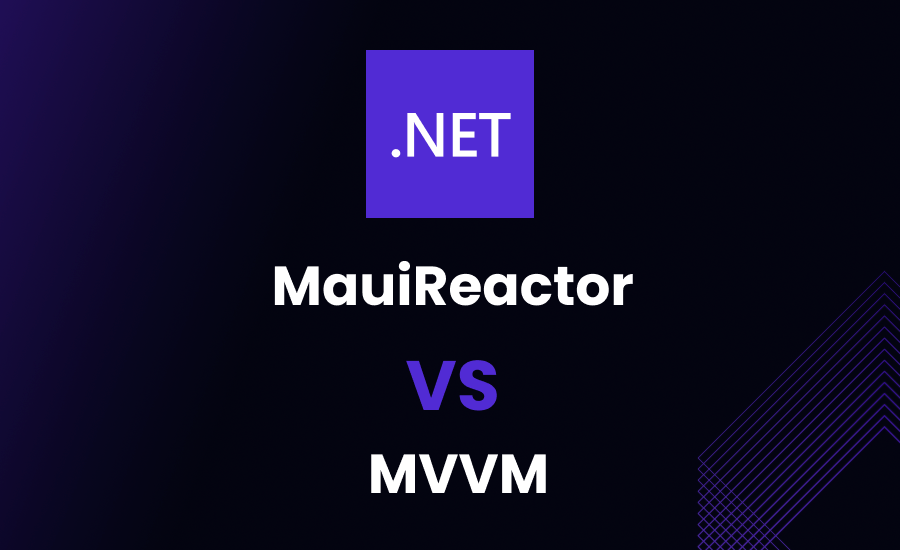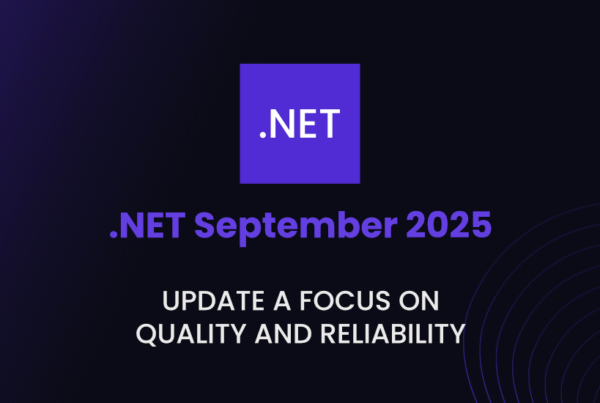f you develop with .NET MAUI, this story will sound familiar: you spend valuable time on INotifyPropertyChanged boilerplate, you fight with a Hot Reload that doesn’t always behave as you expect, and you wonder if XAML is really the most productive way to build UIs in 2025.
The MVVM pattern is powerful, but sometimes it feels like we spend more time writing plumbing code than delivering actual value.
What if we told you there’s another way? An approach already used in ecosystems like React and Flutter, and which is now landing with incredible force in .NET MAUI.
At ByteHide, our mission is to find the tools that define the future. Today, we’re not just giving you a summary; we’re providing a direct analysis of MauiReactor, the open-source library with over 650 stars on GitHub that could change the way you work forever.
What is MauiReactor? The MVU Pattern Revolution in C#
MauiReactor, created by Adolfo Marinucci, implements the MVU (Model-View-Update) pattern. The premise is simple but groundbreaking: your user interface is a function of your application’s state.
This means you write your entire UI in 100% C#, in a declarative way. When the state changes, the UI regenerates to reflect it. It’s a predictable, powerful, and, as we’ll see, incredibly productive model. For those who want to dive deeper into how it works, the official documentation on components and state is an excellent starting point.
Goodbye, Boilerplate: How MauiReactor Simplifies Your Code (With Examples)
The best way to understand it is to see the code. Let’s compare common, everyday tasks.
Example 1: The Login Button
In MVVM, enabling a login button requires an ICommand, a bool property, and a CanExecute method. In MauiReactor, it’s just plain C#:
Button("Login")
.IsEnabled(!string.IsNullOrWhiteSpace(State.FirstName) && !string.IsNullOrWhiteSpace(State.LastName))
.OnClicked(OnLogin)It’s shorter, more readable, and the logic is right where you expect it to be.
Example 2: Displaying a Loading Indicator
In MVVM, this usually requires a BoolToVisibilityConverter. In MauiReactor, it’s a simple ternary expression:
// Instead of a ValueConverter... just this:
State.IsBusy ? new ActivityIndicator() : nullThis level of simplicity is repeated throughout the application, removing unnecessary layers of abstraction.
The Hot Reload We Always Wanted: True Real-Time Development
MauiReactor’s MVU architecture enables a superior hot reload experience. By keeping the state separate from the view logic, you can change almost anything in your code and see the result instantly without losing the application’s context. The data you’ve entered into a form will still be there after the reload. This isn’t a minor improvement; it’s a game-changer for your development cycle.
Your First MauiReactor App: The Counter in 10 Lines of Code
Let’s look at a complete example. Here is the classic counter app, which demonstrates the elegance of the pattern:
class CounterPageState
{
public int Counter { get; set; }
}
class CounterPage : Component<CounterPageState>
{
public override VisualNode Render()
=> new ContentPage("Counter Sample",
new VStack(
new Label($"Counter: {State.Counter}"),
new Button("Click To Increment", () =>
SetState(s => s.Counter++))
)
);
}Notice the clarity:
CounterPageStatedefines the state, isolated and simple.- The
Render()method describes the UI, reading directly fromState.Counter. - The button’s
OnClickedevent usesSetState()to safely modify the state, which automatically triggers a newRender.
And just to show you this pattern is an industry standard, here’s a nearly identical example in React Native:
import React, { useState } from 'react';
import { View, Text, TouchableOpacity } from 'react-native';
const Counter = () => {
const [count, setCount] = useState(0);
return (
<View>
<Text>Count: {count}</Text>
<TouchableOpacity onPress={() => setCount(count + 1)}>
<Text>+</Text>
</TouchableOpacity>
</View>
);
};MauiReactor brings this proven power and simplicity to the .NET ecosystem.
Beyond the Basics: Real-World Features
MauiReactor isn’t just for simple apps. It’s production-ready.
Simple, Integrated Testing
You can test your components in isolation, without bootstrapping the entire platform. It’s compatible with NUnit, xUnit, or your preferred framework.
[Test]
public void Counter_Correctly_Increments_The_Counter()
{
var mainPageNode = TemplateHost.Create(new CounterPage());
// Click the button
mainPageNode.Find<MauiControls.Button>()
.SendClicked();
// Check that the label has been updated
mainPageNode.Find<MauiControls.Label>()
.Text
.ShouldBe($"Counter: 1");
}Third-Party Component Integration (Syncfusion, Telerik, etc.)
Using controls from other vendors is as simple as adding an attribute. MauiReactor’s source generator does the rest.
[Scaffold(typeof(Syncfusion.Maui.Buttons.ToggleButton))]
partial class ToggleButton { }For more complex integrations, the community maintains a repository with examples.
The ByteHide Verdict: Should You Use MauiReactor?
After this technical analysis, our conclusion is clear: MauiReactor is a formidable, production-ready alternative that every .NET MAUI team should evaluate.
- A resounding YES, if… you are looking for maximum productivity, your team comes from backgrounds like React/Flutter, or you simply want to leverage the full power of C# for your UIs.
- Maybe not, if… your team has a decade of experience and is already extremely productive with a mature MVVM and XAML workflow.
It’s not a mandatory replacement, but an evolution that solves real, tangible problems.
Get Started! Try MauiReactor Today
Convinced? Trying it out is incredibly easy.
- Install the template:
dotnet new install Reactor.Maui.TemplatePack- Create your new project:
dotnet new maui-reactor-startup -o MyReactorApp- Run the application:
dotnet build -t:Run -f net9.0-androidFor more information, here are the essential links:
Now it’s your turn.
Share this article with your team and start the debate. Is this the future of .NET MAUI development? Do you think C# code is more maintainable than XAML in the long run?
Leave your opinion in the comments below!
MauiReactor FAQ: Your Questions Answered
What is MauiReactor?
MauiReactor is an open-source library for .NET MAUI that implements the Model-View-Update (MVU) pattern. It allows developers to write their entire user interface declaratively in C# instead of XAML, leading to a more streamlined and productive development experience, similar to modern frameworks like React and Flutter.
Is MauiReactor better than MVVM?
MauiReactor is not necessarily “better,” but it is a powerful alternative that solves different problems.
- Choose MauiReactor if: You want to increase development speed with a superior Hot Reload, reduce boilerplate code (
INotifyPropertyChanged,Commands), and prefer writing your UI directly in C#. It’s especially great for developers with a background in React or Flutter. - Stick with MVVM if: Your team is highly experienced and productive with XAML and the MVVM pattern, and you have a large existing investment in MVVM-based tools and libraries.
How does MauiReactor’s Hot Reload work?
MauiReactor’s Hot Reload is one of its key features. Because the UI is a direct function of a separate state object, the library can reload all the UI and logic code while preserving the current state. This means you can make significant changes to your app’s UI and see them instantly without losing the data you’ve entered or your navigation context, dramatically speeding up development cycles.
Is MauiReactor ready for production applications?
Yes. MauiReactor is a mature library that is actively maintained and used in dozens of real-world production applications. Its design as a thin, auto-generated layer over .NET MAUI makes it stable and easy to update. The library’s creator and community use it for complex enterprise apps that handle offline data synchronization and challenging field conditions.
Can I use third-party controls from Syncfusion or Telerik with MauiReactor?
Yes. MauiReactor is designed to be compatible with the existing .NET MAUI ecosystem. It includes a source generator that can create the necessary wrappers for third-party controls with a simple C# attribute ([Scaffold(...)]). This allows you to integrate complex components from popular vendors like Syncfusion, Telerik, and DevExpress into your MauiReactor application.
How do I start learning MauiReactor?
The fastest way to start is by installing the official project template from the command line: dotnet new install Reactor.Maui.TemplatePack. After that, you can create a new project with dotnet new maui-reactor-startup. The official documentation and the samples repository are the best resources for learning the pattern and exploring its features.




